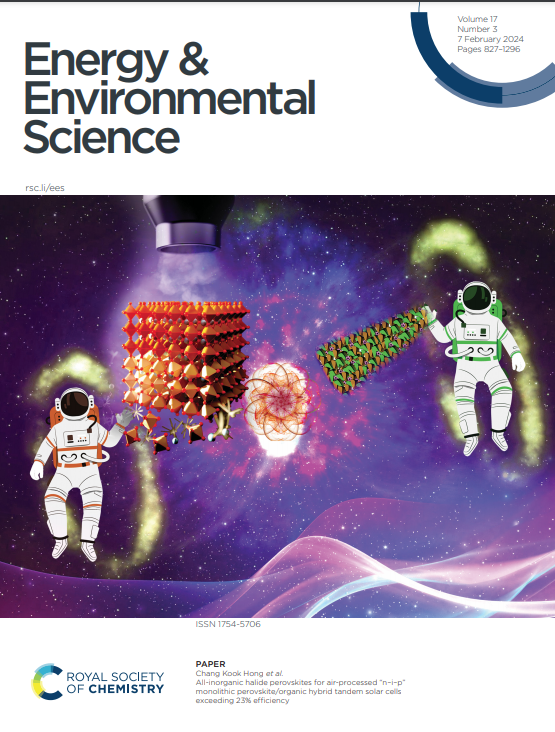Li||NCM811电池在实际操作条件下分子调节膜驱动的电极间相稳定
IF 30.8
1区 材料科学
Q1 CHEMISTRY, MULTIDISCIPLINARY
引用次数: 0
摘要
在高温、低电解质含量和低负极与正极容量比等实际条件下,实现耐用、高能量密度的锂金属电池(lmb)仍然是一个主要挑战。在这里,我们报道了一种结合极性氟和氧基团的分子功能化分离器,通过空间调节界面反应同时稳定锂金属阳极和富镍阴极。这种功能膜促进了阳极氟化锂的均匀形成,抑制了阴极氢氟酸的产生,从而减轻了枝晶生长、结构降解和化学串扰。基于同步加速器的先进纳米计算机断层扫描和扫描透射电子显微镜显示,该分离器显著抑制富镍阴极的晶间开裂和层状到岩盐相变,而密度泛函理论计算阐明了liff促进和pf5稳定的分子水平机制。使用传统碳酸基电解质、高负荷阴极(5.3 mAh cm -2)和薄锂阳极(40 μm)的全电池在55℃下进行208次循环后显示出80%的容量保持率。值得注意的是,在严格的低N/P比和稀薄电解质下工作的袋式双电池实现了385.1 Wh kg cell -1和1135.6 Wh L cell -1的卓越能量密度,包括封装。这些发现强调了一种可扩展的、基于材料的克服界面不稳定性的策略,为下一代lmb的实际部署提供了一条有希望的途径。本文章由计算机程序翻译,如有差异,请以英文原文为准。
Molecule-regulating membrane-driven interphase stabilization of electrodes for Li||NCM811 cells under practical operating conditions
Achieving durable, high-energy-density lithium metal batteries (LMBs) remains a major challenge under practical conditions such as elevated temperatures, lean electrolyte content, and low negative-to-positive capacity ratios. Here, we report a molecularly functionalized separator incorporating polar fluorine and oxygen groups that concurrently stabilize lithium metal anodes and Ni-rich cathodes by spatially modulating interfacial reactions. This functional membrane facilitates uniform lithium fluoride formation at the anode and suppresses hydrofluoric acid generation at the cathode, thereby mitigating dendritic growth, structural degradation, and chemical crosstalk. Advanced synchrotron-based nano-computed tomography and scanning transmission electron microscopy reveal that the separator markedly suppresses intergranular cracking and layered-to-rock-salt phase transitions in Ni-rich cathodes, while density functional theory calculations elucidate the molecular-level mechanisms of LiF promotion and PF 5 stabilization. Full cells using conventional carbonate-based electrolytes, high-loading cathodes (5.3 mAh cm -2 ) and thin lithium anodes (40 μm) demonstrate 80% capacity retention after 208 cycles at 55 o C. Notably, a pouch-type bi-cell operating under stringent low N/P ratio and lean electrolyte achieves exceptional energy densities of 385.1 Wh kg cell -1 and 1135.6 Wh L cell -1 , including packaging. These findings highlight a scalable, materials-based strategy for overcoming interfacial instability, offering a promising route toward practical deployment of next-generation LMBs.
求助全文
通过发布文献求助,成功后即可免费获取论文全文。
去求助
来源期刊

Energy & Environmental Science
化学-工程:化工
CiteScore
50.50
自引率
2.20%
发文量
349
审稿时长
2.2 months
期刊介绍:
Energy & Environmental Science, a peer-reviewed scientific journal, publishes original research and review articles covering interdisciplinary topics in the (bio)chemical and (bio)physical sciences, as well as chemical engineering disciplines. Published monthly by the Royal Society of Chemistry (RSC), a not-for-profit publisher, Energy & Environmental Science is recognized as a leading journal. It boasts an impressive impact factor of 8.500 as of 2009, ranking 8th among 140 journals in the category "Chemistry, Multidisciplinary," second among 71 journals in "Energy & Fuels," second among 128 journals in "Engineering, Chemical," and first among 181 scientific journals in "Environmental Sciences."
Energy & Environmental Science publishes various types of articles, including Research Papers (original scientific work), Review Articles, Perspectives, and Minireviews (feature review-type articles of broad interest), Communications (original scientific work of an urgent nature), Opinions (personal, often speculative viewpoints or hypotheses on current topics), and Analysis Articles (in-depth examination of energy-related issues).
 求助内容:
求助内容: 应助结果提醒方式:
应助结果提醒方式:


